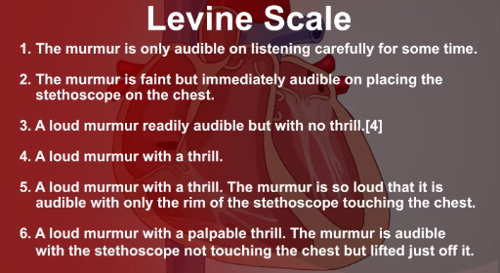Cardiac Exam III: Abnormal Heart Sounds
Source: Suneel Dhand, MD, Attending Physician, Internal Medicine, Beth Israel Deaconess Medical Center
Having a fundamental understanding of normal heart sounds is the first step toward distinguishing the normal from the abnormal. Murmurs are sounds that represent turbulent and abnormal blood flow across a heart valve. They are caused either by stenosis (valve area too narrow) or regurgitation (backflow of blood across the valve) and are commonly heard as a "swishing" sound during auscultation. Murmurs are graded from 1 to 6 in intensity (1 being the softest and 6 the loudest) (Figure 1). The most common cardiac murmurs heard are left-sided murmurs of the aortic and mitral valves. Right-sided murmurs of the pulmonary and tricuspid valves are less common. Murmurs are typically heard loudest at the anatomical area that corresponds with the valvular pathology. Frequently, they also radiate to other areas.

Figure 1. The Levine scale used to grade murmur intensity.
In addition to the two main heart sounds, S1 and S2, which are normally produced by the closing of heart valves, there are two other abnormal heart sounds, known as S3 and S4. These are also known as gallops, because of the "galloping" nature of more than two sounds in a row. S3 is a low-pitched sound heard in early diastole, caused by blood entering the ventricle. S3 is a sign of advanced heart failure, although it can be normal in some younger patients. S4 is heard in late diastole and represents ventricular filling due to atrial contraction in the presence of a stiff ventricle. S4 is also heard in heart failure and left ventricular hypertrophy.
1. Murmurs
- Position the patient at a 30- to 45-degree angle on the examination table.
- When auscultating a murmur, ask the patient to breathe in and out, as it can provide a vital diagnostic clue. Right-sided murmurs (pulmonary and tricuspid) are best heard on inspiration, as blood flows into the right ventricle when intrathoracic pressure decreases. Conversely, left-sided murmurs are heard best on expiration.
- Categorize murmurs according to the following criteria: intensity (loudness), pit
The ability to recognize and distinguish between the different cardiac murmurs develops with time and practice. The first step is to identify normal from abnormal. When a murmur is heard, an examiner should think about the following questions: What part of the cardiac cycle does it occur in - systolic or diastolic? Where is the murmur loudest? Where does the murmur radiate to? Is it loudest on inspiration or expiration?
An examiner should make sure the environment is quiet and that there is am
Перейти к...
Видео из этой коллекции:

Now Playing
Cardiac Exam III: Abnormal Heart Sounds
Physical Examinations I
91.1K Просмотры

General Approach to the Physical Exam
Physical Examinations I
115.2K Просмотры

Observation and Inspection
Physical Examinations I
92.9K Просмотры

Palpation
Physical Examinations I
82.5K Просмотры

Percussion
Physical Examinations I
99.3K Просмотры

Auscultation
Physical Examinations I
60.1K Просмотры

Proper Adjustment of Patient Attire during the Physical Exam
Physical Examinations I
82.9K Просмотры

Blood Pressure Measurement
Physical Examinations I
106.9K Просмотры

Measuring Vital Signs
Physical Examinations I
113.6K Просмотры

Respiratory Exam I: Inspection and Palpation
Physical Examinations I
155.7K Просмотры

Respiratory Exam II: Percussion and Auscultation
Physical Examinations I
211.3K Просмотры

Cardiac Exam I: Inspection and Palpation
Physical Examinations I
175.1K Просмотры

Cardiac Exam II: Auscultation
Physical Examinations I
139.0K Просмотры

Peripheral Vascular Exam
Physical Examinations I
67.7K Просмотры

Peripheral Vascular Exam Using a Continuous Wave Doppler
Physical Examinations I
38.4K Просмотры
Авторские права © 2025 MyJoVE Corporation. Все права защищены